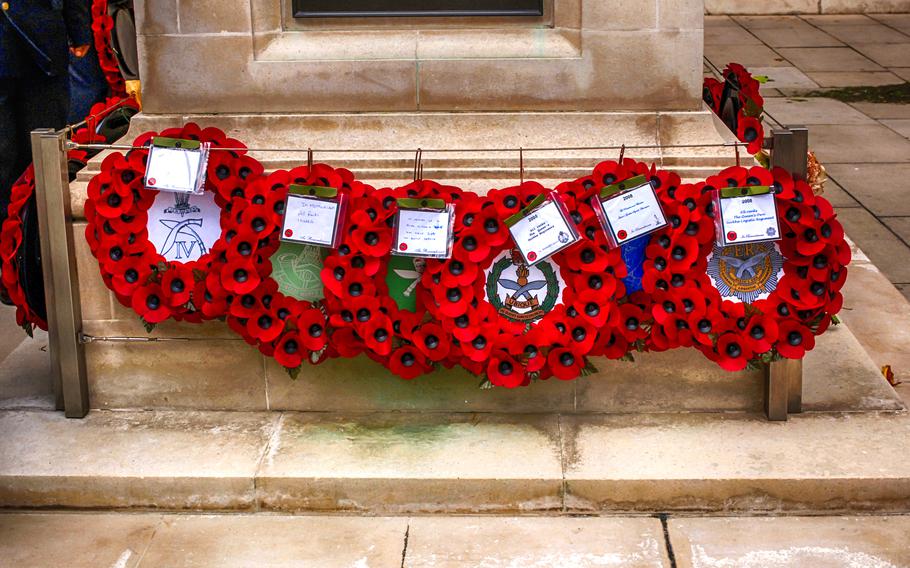
Poppy wreaths are laid on many memorials in Britain on Nov. 11 in honor of Armistice Day, also referred to as Remembrance Day. (iStock)
Of all significant dates across a calendar year, there’s a certain number that stands out, and not only for its unusual appearance: 11/11. Depending on where you might be, Nov. 11 can be a solemn date of remembrance, the feast day of a particularly beloved saint or the kickoff to the carnival season. In a handful of European locations, it would be possible to celebrate all three of the date’s faces with only a minimum of travel involved.
Armistice Day
Armistice Day, also referred to as Remembrance Day in Great Britain and Veterans Day back in the U.S., marks the signing of the document calling for the cessation of hostilities on the Western Front of World War I. The agreement signed on Nov. 11, 1918, between the Allies of World War I and Germany in Compiègne, France, was to enter into effect at the “eleventh hour of the eleventh day of the eleventh month.” The First World War was only officially brought to a close with the signing of the Treaty of Versailles on June 28, 1919.
In Great Britain, the term Poppy Day is used interchangeably for Nov. 11. The Poppy Appeal is the Royal British Legion’s annual campaign to raise funds in support of both past and present members of the armed forces through the sale of poppy lapel pins. The wearing of such a pin between the dates of Nov. 2 (a date also known as All Souls’ Day) and Nov. 11 shows one’s respect for those fallen in service to their country.
Wreath-laying ceremonies take place in cities and towns throughout the land, most of which are organized by local branches of the Royal British Legion on the second Sunday in November. Commonalities of all of these solemn services held in the presence of war veterans include two minutes of silence followed by the firing of field artillery guns.
On Nov. 12, residents of Great Britain will tune in to BBC and other channels to watch the live broadcast of the ceremonies carried out at the Cenotaph in Whitehall in London. In the presence of members of the Royal Family, government officials, former prime ministers, the Mayor of London, representatives of all branches of the Armed Forces and other official figures, the service and sacrifices of those who served will be honored. The national two minutes of silence from 11 a.m. marks the start of the Cenotaph Service. The event is open to all, although space is limited. No special passes or tickets are necessary to attend. Whitehall opens at 8 a.m. on the day, and it’s advisable to reach the area in good time. The sidewalk alongside Parliament provides a good vantage point to the March Past. Video screens erected in the immediate area insure most comers will have something to see.
Those in Belgium can also experience Armistice Day ceremonies, the largest of which are held at the Colonne du Conres in Brussels and the city of Ypres, scene of one of the costliest battles of WWI. The sounding of the Last Post under the Menin Gate in Ypres is a traditional key moment in memory of the country’s fallen.
St. Martin’s Day
Thoughout Germany, predominantly Catholic communities in particular celebrate the feast day of St. Martin with great emotion. On or about Nov. 11, children will march in parades and sing homages to the saint while proudly carrying their homemade lanterns on sticks, and St. Martin’s famed deed of cutting his great coat in half to cover a half-naked beggar freezing in the winter’s cold will be re-enacted. Bonfires and the distribution of baked goods also make up part of the day’s formalities. In the absence of a commemoration in one’s local community, families can make way to Heidelberg, where St. Martin will be feted from 5 p.m. Nov. 12. As per tradition, a parade will kick off at St.-Anna-Gasse in the Old Town and make its way to the Kornmarkt, where the legend of the cutting of the cloak will be performed on stage. Entry is free.
Outside of Germany, St. Martin’s day is also widely celebrated by feasting and the consumption of not only the season’s new wine but wine in general. Good places to experience such festivities include Prague and the Slovenian cities of Ljubljana and Maribor.
Carnival Season begins
The Fifth Season, a term that refers to the period of time leading up to carnival’s big moment, Rose Monday, has a very specific kick-off time: 11:11 a.m. on November 11. In Germany’s carnival strongholds, this date and time does not pass by unnoted. In Cologne, tens of thousands of costumed and perhaps slightly inebriated revelers will gather at the Heumarket, where the three main characters of the Prince, Peasant and the Maiden launch this season within the seasons. In Duesseldorf, carnival season officially begins when the jester known as Hoppeditz awakes from his off-season slumber in front of the city’s Town Hall. Meanwhile, those in Mainz will gather at Schillerplatz for the reading of what is perhaps best translated as the Fool’s Basic Law. At all of these locations, formalities are followed by what can be some pretty wild partying, and with Nov. 11 falling on a Saturday this year, the mood will no doubt be merry and the crowds thick.